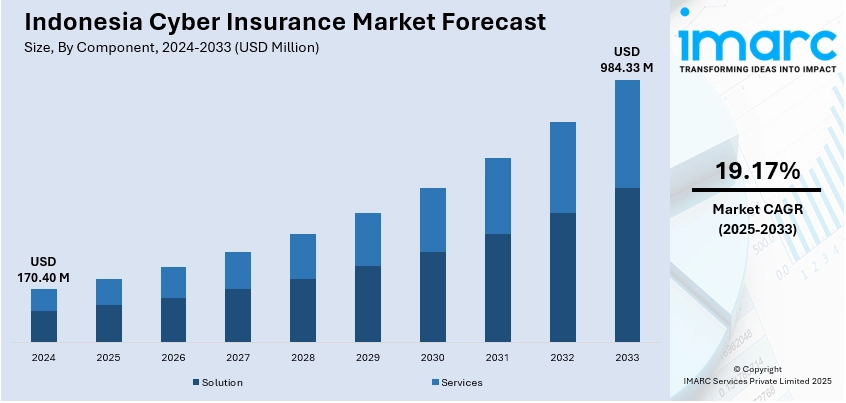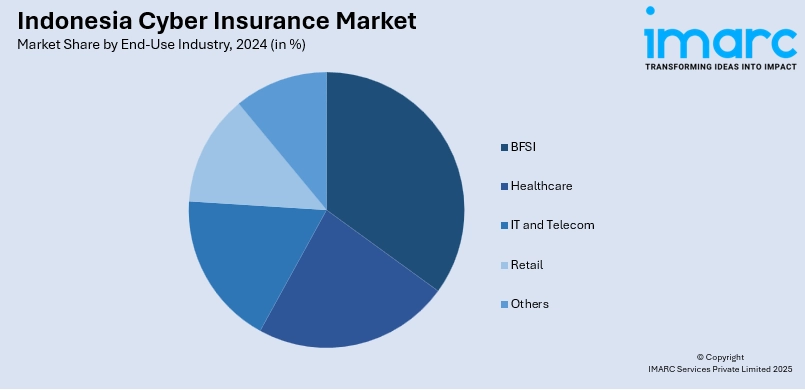
Indonesia Cyber Insurance Market Size, Share, Trends and Forecast by Component, Insurance Type, Organization Size, End-Use Industry, and Region, 2025-2033
Indonesia Cyber Insurance Market Overview:
The Indonesia cyber insurance market size reached USD 170.40 Million in 2024. The market is projected to reach USD 984.33 Million by 2033, exhibiting a growth rate (CAGR) of 19.17% during 2025-2033. The market is growing due to rising cyber threats, increased digital adoption across industries, and stricter data protection laws. In addition, growing awareness among SMEs and the rise of insurtech platforms continue to support Indonesia Cyber insurance market share across key business sectors.
|
Report Attribute
|
Key Statistics
|
|---|---|
|
Base Year
|
2024
|
|
Forecast Years
|
2025-2033
|
|
Historical Years
|
2019-2024
|
| Market Size in 2024 | USD 170.40 Million |
| Market Forecast in 2033 | USD 984.33 Million |
| Market Growth Rate 2025-2033 | 19.17% |
Indonesia Cyber Insurance Market Trends:
Rising Digital Risks Fuel Demand
The Indonesia cyber insurance market growth is being driven by the increasing number of digital threats and the growing reliance on online infrastructure. As businesses in the country expand their digital operations, the chances of facing cyber incidents like data theft, ransomware, and network breaches have increased. Companies, especially those in finance, retail, and logistics, are beginning to realize the financial and operational damage that cyberattacks can cause. This shift in awareness is creating stronger interest in insurance coverage designed specifically to handle such risks. The past year has seen a rise in targeted malware and phishing attacks on Indonesian businesses, including smaller firms that were once considered less attractive to cybercriminals. In response, cyber insurance providers have started revising their products, offering more flexible terms and broader protection. Partnerships between insurers and cybersecurity firms have also become more common, combining technical monitoring with financial coverage. Some local insurers are introducing pre-incident services like risk assessments and employee training to reduce exposure. These developments show how the market is adjusting to a wider threat base and shifting customer needs.

To get more information on this market, Request Sample
Compliance Pressure Shapes Product Demand
Regulations related to digital safety and data use are prompting more companies in Indonesia to look at cyber insurance as a necessary part of their business strategy. Government policies now require firms to strengthen internal controls for handling user data, especially since the introduction of the personal data protection law. Moreover, organizations are turning to insurance to help manage the potential financial impact of violations, legal claims, and system failures with regulatory oversight becoming stricter. It is no longer just major corporations feeling this pressure mid-sized and even smaller companies handling sensitive data are now taking notice. Recent actions by authorities include public warnings, industry-specific guidelines, and coordinated efforts with private firms to raise the overall standard of cybersecurity. In turn, insurance providers are rolling out packages tailored for regulated industries like banking and healthcare. These packages often include support for post-breach investigation, legal fees, and customer notification expenses. Larger enterprises are also requiring their vendors and partners to carry cyber coverage, pushing adoption through supply chains. With these changes taking hold, the market is starting to see more customized offerings based on business size, sector, and risk level. This trend is steadily expanding the reach and relevance of cyber insurance across Indonesia’s digital economy.
Indonesia Cyber Insurance Market Segmentation:
IMARC Group provides an analysis of the key trends in each segment of the market, along with forecasts at the country and regional level for 2025-2033. Our report has categorized the market based on component, insurance type, organization size, and end-use industry.
Component Insights:
- Solution
- Services
The report has provided a detailed breakup and analysis of the market based on the component. This includes solution and services.
Insurance Type Insights:
- Packaged
- Stand-alone
The report has provided a detailed breakup and analysis of the market based on the insurance type. This includes packaged and stand-alone.
Organization Size Insights:
- Small and Medium Enterprises
- Large Enterprises
The report has provided a detailed breakup and analysis of the market based on the organization size. This includes small and medium enterprises and large enterprises.
End-Use Industry Insights:

- BFSI
- Healthcare
- IT and Telecom
- Retail
- Others
The report has provided a detailed breakup and analysis of the market based on the end-use industry. This includes BFSI, healthcare, IT and telecom, retail, and others.
Regional Insights:
- Java
- Sumatra
- Kalimantan
- Sulawesi
- Others
The report has also provided a comprehensive analysis of all the major regional markets, which include Java, Sumatra, Kalimantan, Sulawesi, and others.
Competitive Landscape:
The market research report has also provided a comprehensive analysis of the competitive landscape. Competitive analysis such as market structure, key player positioning, top winning strategies, competitive dashboard, and company evaluation quadrant has been covered in the report. Also, detailed profiles of all major companies have been provided.
Indonesia Cyber Insurance Market News:
- June 2025: Erajaya Digital and bolttech launched a comprehensive device protection programme in Indonesia, combining physical device repair and cyber protection. This move significantly impacted the cyber insurance market by offering customers enhanced digital security, with features like personal data leak monitoring, boosting consumer demand for integrated protection solutions.
- September 2024: FPT IS and Metrodata formed a joint venture to focus on cybersecurity solutions, marking a significant step in Indonesia's digital transformation. This collaboration strengthened the Indonesia cyber insurance market by enhancing cybersecurity services, creating greater demand for comprehensive cyber insurance and risk management solutions.
Indonesia Cyber Insurance Market Report Coverage:
| Report Features | Details |
|---|---|
| Base Year of the Analysis | 2024 |
| Historical Period | 2019-2024 |
| Forecast Period | 2025-2033 |
| Units | Million USD |
| Scope of the Report |
Exploration of Historical Trends and Market Outlook, Industry Catalysts and Challenges, Segment-Wise Historical and Future Market Assessment:
|
| Components Covered | Solution, Services |
| Insurance Types Covered | Packaged, Stand-alone |
| Organization Sizes Covered | Small and Medium Enterprises, Large Enterprises |
| End-Use Industries Covered | BFSI, Healthcare, IT and Telecom, Retail, Others |
| Regions Covered | Java, Sumatra, Kalimantan, Sulawesi, Others |
| Customization Scope | 10% Free Customization |
| Post-Sale Analyst Support | 10-12 Weeks |
| Delivery Format | PDF and Excel through Email (We can also provide the editable version of the report in PPT/Word format on special request) |
Key Questions Answered in This Report:
- How has the Indonesia cyber insurance market performed so far and how will it perform in the coming years?
- What is the breakup of the Indonesia cyber insurance market on the basis of component?
- What is the breakup of the Indonesia cyber insurance market on the basis of insurance type?
- What is the breakup of the Indonesia cyber insurance market on the basis of organization size?
- What is the breakup of the Indonesia cyber insurance market on the basis of end-use industry?
- What is the breakup of the Indonesia cyber insurance market on the basis of region?
- What are the various stages in the value chain of the Indonesia cyber insurance market?
- What are the key driving factors and challenges in the Indonesia cyber insurance market?
- What is the structure of the Indonesia cyber insurance market and who are the key players?
- What is the degree of competition in the Indonesia cyber insurance market?
Key Benefits for Stakeholders:
- IMARC’s industry report offers a comprehensive quantitative analysis of various market segments, historical and current market trends, market forecasts, and dynamics of the Indonesia cyber insurance market from 2019-2033.
- The research report provides the latest information on the market drivers, challenges, and opportunities in the Indonesia cyber insurance market.
- Porter's Five Forces analysis assists stakeholders in assessing the impact of new entrants, competitive rivalry, supplier power, buyer power, and the threat of substitution. It helps stakeholders to analyze the level of competition within the Indonesia cyber insurance industry and its attractiveness.
- Competitive landscape allows stakeholders to understand their competitive environment and provides an insight into the current positions of key players in the market.
Need more help?
- Speak to our experienced analysts for insights on the current market scenarios.
- Include additional segments and countries to customize the report as per your requirement.
- Gain an unparalleled competitive advantage in your domain by understanding how to utilize the report and positively impacting your operations and revenue.
- For further assistance, please connect with our analysts.
 Request Customization
Request Customization
 Speak to an Analyst
Speak to an Analyst
 Request Brochure
Request Brochure
 Inquire Before Buying
Inquire Before Buying




.webp)




.webp)












